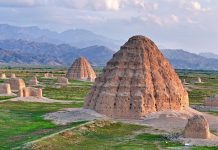BEIJING: At the first sight of the huge sculpture of a coin set in Jinggangshan in east China’s Jiangxi Province, Diego Barroso, a Mexican language teacher based in Shanghai, wonders how the pattern of Latin America occurs on the China-made coins.
The coin, made by the Red Army Mint during the Chinese revolution, was engraved with an eagle with a snake in its mouth which is standing on a cactus growing between rocks in the lake. On the wings of the eagle engraved the Chinese character “Gong,” which means workers. The picture is quite similar to the national emblem of Mexico. To figure out the connection shown on coins between the two countries, Barroso came to Jinggangshan, the “cradle” of the Chinese revolution.
In 1928, in a bid to consolidate and develop revolutionary base areas, forefathers of the Communist Party of China (CPC) Mao Zedong and Zhu De with their army built the Red Army Mint in Jinggangshan, modeling the Mexican silver dollar to produce its own.
A professor from the China Executive Leadership Academy in Jinggangshan explained to Barroso why they chose Mexican money.
“During the late Qing Dynasty and the Republic of China (1912-1949) period, the Mexican silver dollar was one of the most used foreign money in southern and central China,” said Wen Shangqing, an expert in the economic history of the CPC.
As early as in the colonial time, some well-known silversmiths in Mexico started to make silver coins and moulds, some of which circulated to other countries including China, said Javier Ocampo, a Mexican expert in local chronicles study.
“After the Red Army Mint opened, workers used silver and jewelry captured from the enemy to mint coins, on which they engraved the Chinese character ‘Gong’ to represent the government of workers, peasants and soldiers,” said Li Haiquan, director of the Red Army Mint Site in Jinggangshan. – Agencies





